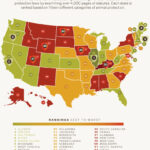The issue of animal cruelty is pervasive and varies dramatically across the globe. While the severity and types of animal abuse can differ from one region to another, certain countries emerge with dismal records that highlight profound systemic issues related to animal rights. Understanding the places where animal cruelty runs rampant opens our eyes to the challenges faced by countless creatures, and it allows society to pivot towards solutions that can mitigate suffering.
To delve into this morbid landscape, we must first acknowledge that animal cruelty can take several forms. From direct violence against pets and livestock to the exploitation of wild animals, cruelty manifests itself in both domestic settings and through industrial practices. Each act of abuse serves as an unfortunate testament to humanity’s failure to empathize with other sentient beings.
Countries with the most significant records of animal cruelty often boast insufficient legal protections for animals. These locales typically exhibit cultural attitudes that prioritize economic gain over ethical considerations. For instance, nations with extensive agricultural industries may prioritize profits from animal husbandry at the expense of humane treatment. In such circumstances, welfare standards can become lax, allowing for practices that would be considered abhorrent in more progressive societies.
One prominent area of concern is the unregulated fishing industries in certain countries. Nations that rely heavily on fishery exports often overlook the suffering endured by marine creatures. Some fishing practices utilize methods that are not only efficient but also grotesquely cruel. Trawlers can inadvertently ensnare dolphins and sea turtles, leading to brutal deaths through drowning or injury. This is a poignant illustration of how the quest for economic gain can foster environments where animal cruelty thrives without consequence.
Additionally, the fur industry paints a bleak picture in several countries that have not enacted comprehensive animal welfare laws. Countries such as China and Russia still engage in practices that can only be described as barbaric. Animals raised for fur often endure lives of extreme confinement, and their deaths are typically shrouded in an ominous secrecy that hides the horrific methods employed to harvest their pelts. The very act of commodifying life strips away the intrinsic value of these beings, reducing them to mere products that can be discarded without a second thought.
Beyond industrial practices, we must confront the societal norms that perpetuate cruelty. In nations where dog fighting and cockfighting are still culturally accepted, such practices may be viewed as traditions or forms of entertainment. Here, the dismal reality involves not just physical torture but a complete disregard for the mental anguish experienced by the animals involved. Legal ramifications for such abuses often remain minimal, as societal attitudes can sometimes shield perpetrators from accountability.
Another horrifying example can be found in countries that engage in the illegal wildlife trade, such as Vietnam and countries in Africa. The rampant poaching for ivory, rhino horn, and exotic pets nurtures a cycle of violence against animals whose populations are dwindling toward extinction. Elephants are often killed at alarming rates simply to satisfy a black market demand for ivory. The ramifications extend beyond the individual animals; entire ecosystems suffer as a result of the loss of these keystone species.
Countries like India, despite having laws in place to protect animals, continue to grapple with cruelty against stray dogs and cats. The lack of enforcement of animal welfare legislation leads to a culture of neglect and violence. Ritualistic abuses, such as the throwing of stray animals into rivers as part of so-called “cleansing” ceremonies, exemplify how deeply entrenched misconceptions about animal rights can lead to appalling acts of violence.
When we illuminate these dark corners across the globe, we also unveil an opportunity for transformation. Advocacy, education, and stricter enforcement of existing laws can serve as crucial components in reversing these grim trends. Moreover, raising awareness about the inherent suffering animals endure because of human actions can ignite a vital shift in public perception. This shift is crucial to fostering an empathetic relationship between humans and the animal kingdom.
Grassroots movements focused on animal welfare are becoming increasingly prominent, demonstrating that many individuals are willing to take a stand against cruelty. From social media campaigns aimed at curbing the fur trade to local initiatives that promote responsible pet ownership, the collaboration between activists can bolster legal protections. Where once there existed apathy, there is now a burgeoning interest in animal rights that cannot be ignored.
Addressing animal cruelty requires a multifaceted approach that goes beyond mere awareness. It demands a coalition of voices advocating for legislative reform and societal introspection. Countries must reassess their values, prioritizing compassion over exploitation. Cultivating empathy towards our fellow species is not merely an ideal; it is an imperative that demands collective action.
In conclusion, while the evidence of animal cruelty may be disheartening, it also serves as a clarion call for concerted action. By shedding light on the countries that persistently face these issues, we encourage informed discussions surrounding animal welfare and galvanize efforts for change. The path towards a more compassionate world is fraught with challenges, but a driven community can pave the way for a brighter future where all creatures are treated with the dignity and respect they so richly deserve.







